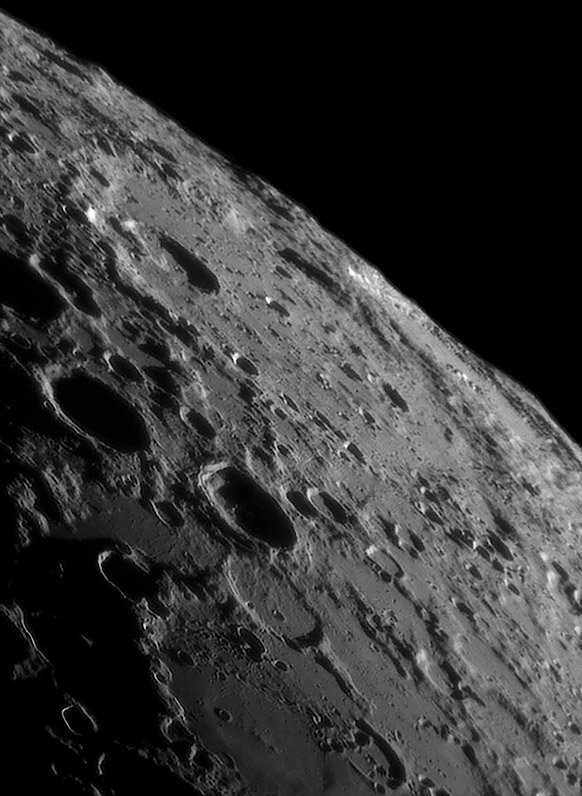Difference between revisions of "January 25, 2018"
(Created page with "__NOTOC__ =Especially Worthy of Scrutiny= Originally published August 4, 2008 <!-- Start of content --> <!-- ws:start:WikiTextHeadingRule:1:<h1> --> <!-- ws:start:W...") |
|||
| Line 7: | Line 7: | ||
<em>image by [mailto:bob_p@earthlink.net Bob Pilz]</em><br /> | <em>image by [mailto:bob_p@earthlink.net Bob Pilz]</em><br /> | ||
<br /> | <br /> | ||
| − | There is almost nothing as large as Bailly on the easily seen parts of the nearside. Bailly's diameter is about 300 km, and only four other nearside craters are larger than 200 km: Deslandres, Clavius, Grimaldi and Schickard. Bob provides a glorious view across the vast feature that [ | + | There is almost nothing as large as Bailly on the easily seen parts of the nearside. Bailly's diameter is about 300 km, and only four other nearside craters are larger than 200 km: Deslandres, Clavius, Grimaldi and Schickard. Bob provides a glorious view across the vast feature that [https://the-moon.us/wiki/Elger%2C+1895 Elger] said was <em>especially worthy of scrutiny</em>. The far wall is best seen (because its aimed at us) and shows some remnant terraces and a local high spot. The floor of Bailly is mostly unremarkable, but there is a suggestion that the outer third of the floor is less rugged and has fewer craters than the inner part. And that is true, for Bailly is a two-ring impact basin, whose fragmentary inner ring is best visible from an overhead view. A good model for the a two-ring basin is the one directly in front of Bailly. The [[October_17,_2004|Schiller-Zucchius Basin]] is 335 km in diameter with a rather massive 175 km inner ring. Bob's image shows the best preserved pieces of the outer and inner rings at bottom left. His low-Sun view captures the smaller dimple that may be yet another, lava-flooded inner, inner ring. So Bailly doesn't belong in the list of largest nearside craters because it is really a basin, and - surprise - so is [https://the-moon.us/wiki/Grimaldi Grimaldi], whose 230 wide rim is actually an inner ring of a 440 km diameter basin. The largest nearside crater is thus [[May_7,_2004|Deslandres]]... but I bet it is a basin too, whose inner ring is mostly gone.<br /> |
<br /> | <br /> | ||
<em>[mailto:tychocrater@yahoo.com Chuck Wood]</em><br /> | <em>[mailto:tychocrater@yahoo.com Chuck Wood]</em><br /> | ||
Revision as of 18:18, 18 August 2018
Especially Worthy of Scrutiny
Originally published August 4, 2008

image by Bob Pilz
There is almost nothing as large as Bailly on the easily seen parts of the nearside. Bailly's diameter is about 300 km, and only four other nearside craters are larger than 200 km: Deslandres, Clavius, Grimaldi and Schickard. Bob provides a glorious view across the vast feature that Elger said was especially worthy of scrutiny. The far wall is best seen (because its aimed at us) and shows some remnant terraces and a local high spot. The floor of Bailly is mostly unremarkable, but there is a suggestion that the outer third of the floor is less rugged and has fewer craters than the inner part. And that is true, for Bailly is a two-ring impact basin, whose fragmentary inner ring is best visible from an overhead view. A good model for the a two-ring basin is the one directly in front of Bailly. The Schiller-Zucchius Basin is 335 km in diameter with a rather massive 175 km inner ring. Bob's image shows the best preserved pieces of the outer and inner rings at bottom left. His low-Sun view captures the smaller dimple that may be yet another, lava-flooded inner, inner ring. So Bailly doesn't belong in the list of largest nearside craters because it is really a basin, and - surprise - so is Grimaldi, whose 230 wide rim is actually an inner ring of a 440 km diameter basin. The largest nearside crater is thus Deslandres... but I bet it is a basin too, whose inner ring is mostly gone.
Chuck Wood
Technical Details
2008/07/28, ~10:23 UT. 200mm f/6 Newtonian, Televue 2.5X Barlow, DMK 21BF04 B/W camera, Blue IR-block. Taken from Lat: 35 degrees 36 minutes N, Long: 82 degrees 33 minutes W, Elev: ~850m
Related Links
Rükl plate 71
Opposite illumination view
Yesterday's LPOD: Rim Peaks?
Tomorrow's LPOD: Aristarchian Colors
COMMENTS?
Register, Log in, and join in the comments.



